The decision by the previous Conservative government in the United Kingdom to approve the giant Rosebank oilfield off Shetland was ruled unlawful by an Edinburgh court on Thursday.
The judgment by Lord Ericht at the Court of Session said the carbon emissions that would be created by the burning of oil and gas at the largest untapped oilfield in the UK had not been taken into consideration.
“Today’s ruling is part of a clear trend we’re seeing from courts in the UK – marking the third time in the last year that judges have found that ‘downstream’ emissions must be considered in planning decisions,” said ClientEarth lawyer Robert Clarke, in a press release from ClientEarth. “This is a resounding signal from the courtroom that companies and governments can no longer turn a blind eye to the vast majority of the emissions their coal, oil and gas fields create.”
BREAKING:
ROSEBANK OIL FIELD DECLARED UNLAWFUL!
This is huge victory for climate justice + people power!

Political attention must immediately turn to developing an urgent and fair transition plan for oil workers.
— Friends of the Earth Scotland
(@foescot.bsky.social) January 30, 2025 at 5:07 AM
The court also ruled that consent for Shell’s Jackdaw gas field was unlawful and that owners of both oilfields needed to seek new government approval before production could start, reported BBC News.
The judgment followed a case brought by Greenpeace and Uplift.
Lord Ericht said a more detailed environmental impact assessment would be needed that takes into account the climate effects of burning any extracted fossil fuels.
Work on both fields will be allowed to continue while the new information is gathered; however, no oil and gas can be extracted without the granting of new approval.
Permission for Rosebank’s North Atlantic oil development was given in 2023, while approval for the smaller Jackdaw gas field, located in the North Sea, was granted in the summer of 2022.
Lord Ericht wrote in the 57-page judgment that remaking the decision “on a lawful basis” was in the public interest due to the impacts of climate change, which outweighed the developers’ interests.
Uplift Executive Director Tessa Khan said the current Labour government should deny approval for both projects.
“The climate science is crystal clear that we can’t create new oil and gas fields if we’re going to stay within safe climate thresholds,” Khan said, as BBC News reported.
Philip Evans, a senior campaigner with Greenpeace, called the judgment “a historic win,” reported The Guardian.
“The age of governments approving new drilling sites by ignoring their climate impacts is over,” Evans said. “The courts have agreed with what climate campaigners have said all along: Rosebank and Jackdaw are unlawful, and their full climate impacts must now be properly considered.”
Campaigners had argued that oil and gas exploration in the North Sea would not bring any economic or energy security and that there was no climate rationale behind it.
“Any institutional investor, asset manager or lender backing new fossil fuel projects in the UK is now gambling on a high-risk strategy for its clients with financial prospects seriously in doubt,” Clarke said in the press release. “New fossil fuel projects in the UK have never been a riskier investment – and financial institutions both at home and abroad must take that into account when it comes to their portfolios.”
The International Energy Agency has repeatedly said that there should be no new drilling for oil and gas if we are to keep global heating from exceeding the 1.5 degrees Celsius threshold recommended by the 2015 Paris Agreement.
Climate activists and trade unions have argued that the UK government should be investing in renewable energy in order to meet climate goals and provide cheap and secure energy, The Guardian reported.
James Alexander, UK Sustainable Investment and Finance Association chief executive, called renewables the “UK’s key growth sector of the future.”
“That is where we should be focusing our upskilling efforts and attracting the billions available in private investment,” Alexander said.
The court’s ruling sends the decision on Rosebank — primarily owned by Equinor — and Jackdaw back to the government. A UK Department for Energy Security and Net Zero spokesperson said the government was receiving environmental guidance that takes emissions from oil and gas into account and was expected to deliver an update in the spring.
“We will respond to this consultation as soon as possible and developers will be able to apply for consents under this revised regime. Our priority is to deliver a fair, orderly and prosperous transition in the North Sea in line with our climate and legal obligations, which drives towards our clean energy future of energy security, lower bills, and good, long-term jobs,” the spokesperson said.
Stop Rosebank campaigner Lauren MacDonald said the development would bring more harm than benefits to Scotland.
“Almost all of Rosebank’s oil would be sold overseas, doing nothing to lower our bills or make us more secure, with most of the profits going straight to the state-backed Norwegian firm, Equinor,” MacDonald said, as reported by The Guardian. “It’s not fair that people here are now suffering the impacts of climate change, which is driven by fossil fuels and which will get worse as long as companies are allowed to open huge new drilling sites.”
The post In ‘Historic Win,’ Court Rules Against UK’s Rosebank Oilfield Over Climate Impacts appeared first on EcoWatch.
https://www.ecowatch.com/rosebank-oilfield-unlawful-climate-impacts.html
Green Living
6 Best Non Toxic Diapers For Babies
Last Updated on October 15, 2025
Did you know the average newborn goes through 10-12 diapers per day? That’s a lot of waste – and a lot of time spent in diapers.
Most babies have more sensitive skin than adults, as their skin hasn’t fully developed yet. The protective hydrolipidic film is still very thin, which makes infant skin more vulnerable to harsh external factors.

Some of the links in this post are affiliate links; for more information please see my disclosure policy.
Those external factors include diapers. Babies spend a lot of time getting in (and out) of them. So it’s important to choose non toxic diapers that are gentle on both skin and planet. Here are the best non toxic diapers on the market.
which diapers are the least toxic?
The diapers that are least toxic include ones made from plant-based or cotton materials. Look for brands that omit harsh chemicals like chlorine, phthalates, and PFAs.
Many diaper components are made up of plastic, which is hard to avoid in the name of efficiency.
That being said, it’s best to choose diapers from brands that minimize the amount of plastic in their products. Plastic materials can emit VOCs known to harm health.
Here are some general guidelines to adhere to when choosing diapers:
- Choose diapers that disclose the ingredients (some don’t!). Avoid anything with fragrance, lotion, or other skin-conditioning adhesives.
- Look for brands that minimize the amount of plastic in their products.
- Consider cloth diapers, ideally made from organic cotton.
- Opt for brands that use unbleached pulp or pulp bleached without chlorine
- Try to choose plain, undyed diapers with minimal designs (dyes can be contaminated with toxic heavy metals).
- Check for certifications like Forest Stewardship Council or EWG certified.

is Huggies or Pampers less toxic?
In terms of being less toxic, Huggies has stated all of their diapers are free of fragrances, phthalates, parabens, and elemental chlorine. They’ve also partnered with Terracycle to offer plastic film recycling options.
Pampers diapers are made without parabens, natural rubber latex and elemental chlorine. But only their Pure diapers are made without fragrance (and many mothers online have complained of Pampers’ strong scent).
However, Pampers’ factories are zero manufacturing waste to landfill and they use FSC certified wood pulp.
Both brands list their ingredients on their websites, so definitely read them for yourself before making a purchase. Just be mindful both brands also use colorants and printing inks to make designs and/or color change technology.
which diaper brands are safe for babies?
The diaper brands safe for babies are listed below. There’s a mix of disposable and cloth diapers, so there’s something for everyone.
However, be mindful that every baby is different and what works for one, doesn’t always work for another. For example, certain brands may fit your baby like a glove, whereas others may be too big: It’s all about experimenting and finding what works for your baby.
You can use this list as a starting point to help you choose a better, safer choice for your child. None of the brands listed here use fragrance, parabens, or other harsh chemicals.
I’ve gone ahead and highlighted some of my favorite features of each brand, but it isn’t an exhaustive list. Be sure to check out their websites for more information.
Also, if you cloth diaper, don’t forget to consider eco-friendly baby detergent brands because you’ll be doing a bit more laundry!
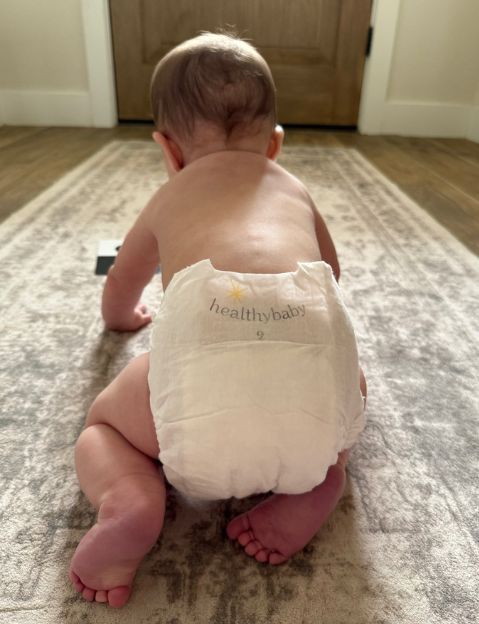
1. healthy baby
- Offers disposable and cloth diapering options
- Six sizes, not including newborn (N or N/1)
- Plant-based materials including organic cotton + FSC certified pulp
- 12 hour leak protection
- No chemical wetness indicator
- EWG certified
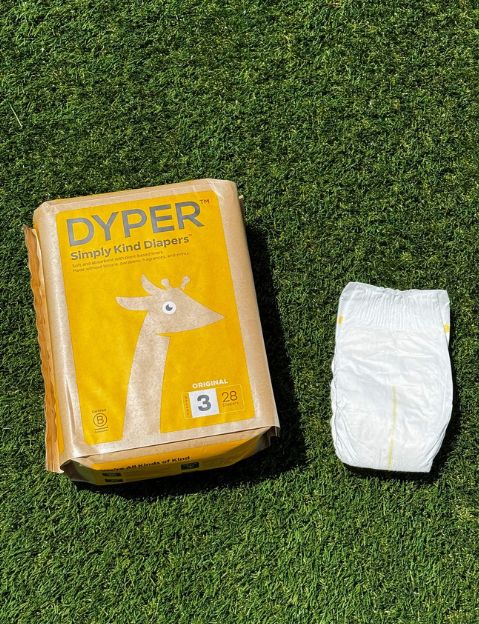
2. dyper
- Disposable diapers
- Six sizes, not including newborn (NB)
- Plant-based materials, including FSC-certified pulp
- 12-hour leak protection
- No inks, prints or dyes
- Offers REDYPER service to compost diapers through weekly pickup
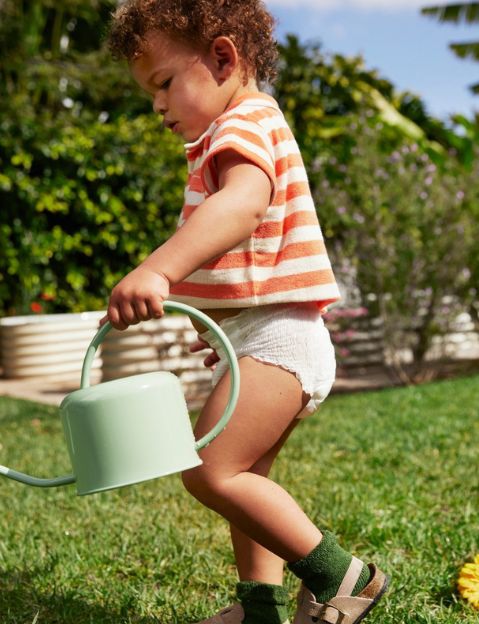
3. coterie
- Disposable diapers
- Seven sizes, not including newborn (N or N+1)
- 25% plant-based, made with wood pulp from sustainably manages forests
- 12-hour leak protection
- Wetness indicator
- Cruelty-free
- OEKO-TEX STANDARD 100 Certified
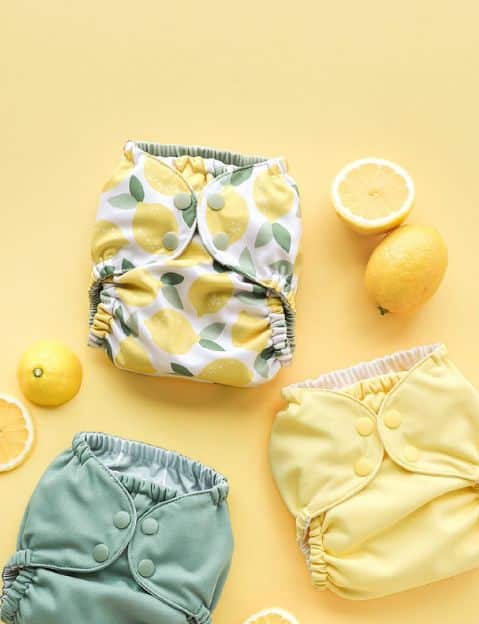
4. esembly baby
- Cloth diapers
- Two sizes, based on pounds
- Made of organic cotton + upcycled TPU
- Recommended to change an awake baby every 2-3 hours
- Wet bags sold separately to hold dirty diapers while out
- Pre-loved options to buy and sell available
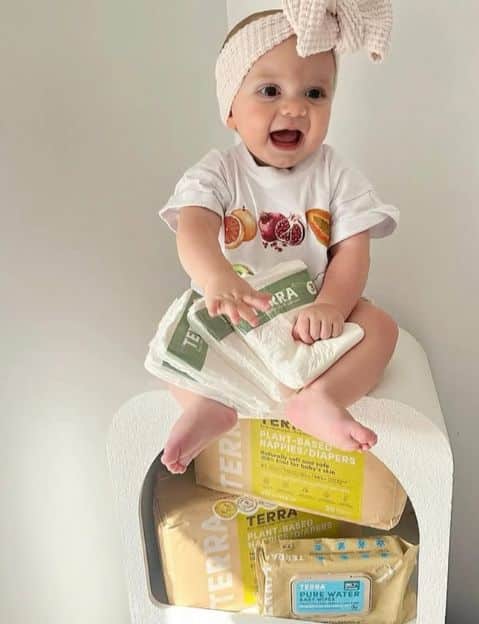
5. terra
- Disposable diapers
- Six sizes
- 85% plant-based, including FSC-certified pulp
- 12-hour leak-proof protection
- Plant-based wetness indicator
- Ink on product + packaging is food grade
- Packaging is made from recyclable kraft paper + rice
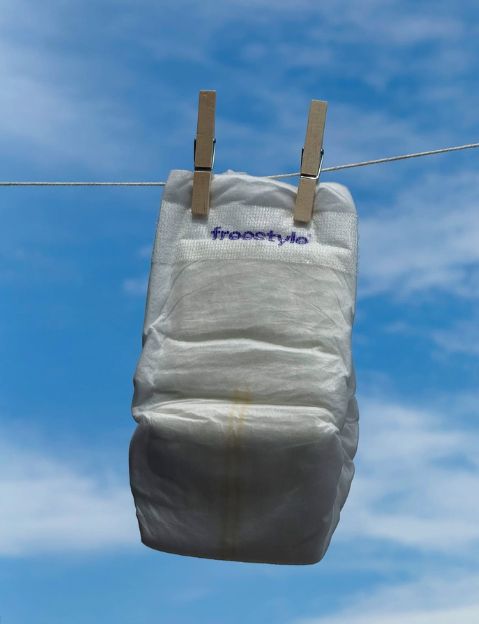
6. freestyle
- Disposable diapers
- Six sizes
- 7-layer protection for 14x better absorption
- Delivered in 1 month long supplies
- FSC certified pulp
- EWG verified
Which of these sustainable diaper options would you choose? Let me know in the comments!
The post 6 Best Non Toxic Diapers For Babies appeared first on Going Zero Waste.
Green Living
The Many Layers of Personal Style
Personal style is a dance between dualities: fashion as art and fashion as function; clothing as self-expression and clothing for our circumstances.
Style is a medium for communication and self-expression, yes. But it’s also shaped by the environments and requirements around us, from workplace dress codes to city cultures, climates, and specific occassions.
In last Saturday’s workshop, where we talked about how to remix what you already have in your closet, attendees shared a common challenge:
How do you balance your personal style expression while dressing for the various situations and environments we operate in?
“I’ve found above all else my style is highly influenced by my environment (my job, my city etc.)—sometimes it becomes about ‘fitting in’ and losing individuality”
“I find I’m too led by my day-to-day lifestyle. I WFH and so often I just don’t get dressed at all.”
“There are too many applications: workout, work, at home, formal occasion.”
Style as Identity vs. Style as Communication
It’s no wonder style and getting dressed can feel so confusing.
In the personal style world, we learn to dress for who we are on the inside. And then we see the style rules in fashion media: here’s how to dress for this season, this dress code, this city.
And in our real lives, we have real dress codes we might have to follow, whether for a workplace or a wedding.
But what if all those sides conflict?
- If my style words are “casual” or “sporty” but I’m in a workplace 40+ hours a week that requires business formal, where does that leave my personal style?
- If I love vibrant and artsy looks, but I live in a city full of neutrals, what do I wear?
It’s no surprise it feels… complicated.
Here’s my take.
We’re Not One-Dimensional — Neither is Our Style
Sometimes I want to disconnect and live in cottage in the mountains, surrounded by more trees than people. Other days I dream of having an apartment in the center of Paris where I see more people in a day than live in my hometown.
I’m light, joyful, maybe even quirky with friends. I’m ambitious, intentional, perhaps more serious in work. There are times I feel it’s best to soften and let it go; other times it feels most aligned to be unapologetically outspoken.
We are human. We’re social creatures. We’re complex and full of contradictions.
Social media has trained us to fit people into neat boxes because “niche” is what performs in the algorithm.
In real life, though, our “authentic” selves aren’t so one-dimensional.
I’m not speaking to new networking contacts the same exact way I talk to my best friend I’ve known for years. That doesn’t mean I’m pretending to be someone else. It just means I’m showing up a bit differently depending on the context.
Similarly, our personal style doesn’t have to be expressed in one singular way.
That’s what’s beautiful about fashion! We have the opportunity to express ourselves a bit differently each and every time we get dressed.
What we wear might ebb and flow with a situation, the season, or our mood. There are common threads, but differentiators too.
Three distinctly different looks can all be authentic.
For me, personal style isn’t about being setting such rigid parameters that we can no longer embrace our multi-dimensional nature.
And there’s undoubtedly the layers of privilege at work here too. Is it safe to dress in alignment with your true identity in that particular situation? Will you be taken seriously? Could there be repercussions?
There’s a lot to untangle when it comes to what we wear.
Making Our Multi-Dimensional Style Practical
As I shared in last week’s workshops, style is many layers. The four I see it through are the vibe, the shapes, the colors & textures, and our lifestyle & values.

The aesthetic reflects your vibe, mood or style adjectives.
- For example, my vibe or adjectives are feminine, structured, grounded.
The shapes are the fits, silhouettes, and proportions you love.
- I often wear outfits with a straight silhouette or tailored fit balanced with a relaxed, flowy, or drapey element.
Colors & textures include your preferred palettes, fabrics, and the way materials feel.
- I prefer wearing natural fibers when possible. I like gold jewelry, and I feel more aligned in lower contrast looks. Lighter colors for day. Sometimes darker for evening or certain events.
The lifestyle & values element is the consideration of your actual day-to-day. What situations and environments are you dressing for? What is important to you?
- I work from home so comfort is key most of the time. I value slow fashion practices — rewearing, repairing, and supporting circular practices and sustainably-minded brands.
Once you understand these layers of your style, the next step is figuring out how to apply them in real-life situations.
Applying Your Style to the Situation
In last week’s workshops, I talked about the role of outfit templates here for various situations. What is the foundational blueprint of what you might wear to your office, working from home, in a school setting, at home, running errands, and so on?
There are opportunities to bring in the layers of your personal style in these various situations, but it does require some intentionally on the outset. Otherwise, it’s easy to fall into our old patterns or copy what others around us wear. (Even subconsciously, as fashion psychologist Shakaila Forbes-Bell has shared!)

Here’s one of my work-from-home outfit templates that balances style and situational needs:
- Blouse with feminine detail: I start with the top for Zoom calls!
- Straight-leg bottoms: this could be jeans, colorful pants, or a column skirt
- Slim shoes: the general “slim” descriptor makes it versatile across seasons
- Structured bag: an option to add polish when coworking at a café
By thinking in these various layers (vibe, shapes, colors & textures, and lifestyle & values) you can build outfits that feel authentic to you while fitting the constraints of the external situation.
What About One-Off Unique Situations?
Like this Wednesday evening, I spoke on a “Sustainable Fashion in Action” panel with Chicago Climate Connect during Sustainable Fashion Week Chicago. But the panel was also taking place at the Patagonia x Worn Wear store.
So the vibe was professional meets fashion, but also kinda casual?! And we are still in the Midwest here. I have to say, this one wasn’t easy.
But here’s the step-by-step thought process that helped me balance my style, function, and a unique-to-me context.

- I picked a foundational piece: My navy wide-leg trousers were business casual without being too formal and were practical for train travel.
- And functional accessories:My old Coach bag fits everything and my chunky Veja sneakers matched the vibe I was going for so those were the picks.
- Then a piece that brought it all together:At this point I was mixing high-contrast colors (white with navy & black) and different vibes (trousers vs. sneakers). I felt like I needed a bridge for the outfit, and this navy-striped vest tied it all together.
- Finally, some final touches: Gold jewelry made the look feel more “me”, while this cap from Abbie at The Filtery made it all feel effortless.
In the end, this outfit took a lot longer to create than a typical look.
It took longer to create than my usual outfits, but it felt just right. The combination was practical, suited my style, fit the vibe of the panel, and aligned with the weather.
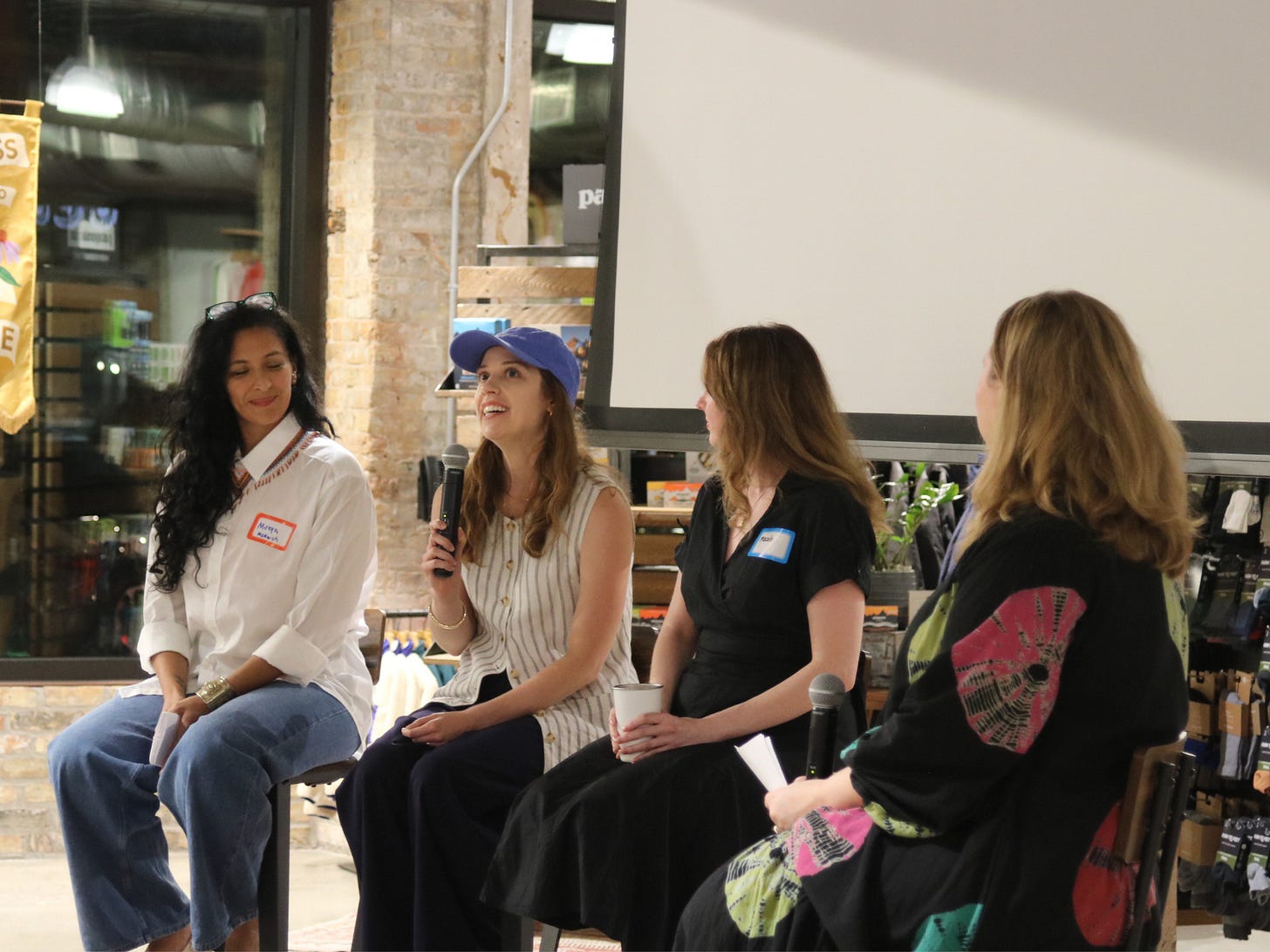
This panel outfit reminded me that style is what we wear to express ourselves, but it’s also a tool to help us navigate our lives. By thinking through these layers of personal style (vibe, shapes, colors, textures, and lifestyle needs) we can balance showing up authentically while honoring the nuances or navigating the constraints of a situation.
For me, that’s the real power of personal style.
One single outfit can’t tell the whole story of who we are. But personal style can be flexible, functional, and expressive of the many sides of our multi-dimensional nature.
So lately, more than asking “does this outfit perfectly express my full self?” I’ve been finding myself asking:
“Does this outfit help me show up in the way I want to? Does it say what I want it to say in this particular moment?“
The post The Many Layers of Personal Style appeared first on .
Green Living
You’re multi-dimensional. So is your style.
Personal style is a dance between dualities: fashion as art and fashion as function; clothing as self-expression and clothing for our circumstances.
Style is a medium for communication and self-expression, yes. But it’s also shaped by the environments and requirements around us, from workplace dress codes to city cultures, climates, and specific occassions.
In last Saturday’s workshop, where we talked about how to remix what you already have in your closet, attendees shared a common challenge:
How do you balance your personal style expression while dressing for the various situations and environments we operate in?
“I’ve found above all else my style is highly influenced by my environment (my job, my city etc.)—sometimes it becomes about ‘fitting in’ and losing individuality”
“I find I’m too led by my day-to-day lifestyle. I WFH and so often I just don’t get dressed at all.”
“There are too many applications: workout, work, at home, formal occasion.”
Style as Identity vs. Style as Communication
It’s no wonder style and getting dressed can feel so confusing.
In the personal style world, we learn to dress for who we are on the inside. And then we see the style rules in fashion media: here’s how to dress for this season, this dress code, this city.
And in our real lives, we have real dress codes we might have to follow, whether for a workplace or a wedding.
But what if all those sides conflict?
- If my style words are “casual” or “sporty” but I’m in a workplace 40+ hours a week that requires business formal, where does that leave my personal style?
- If I love vibrant and artsy looks, but I live in a city full of neutrals, what do I wear?
It’s no surprise it feels… complicated.
Here’s my take.
We’re Not One-Dimensional — Neither is Our Style
Sometimes I want to disconnect and live in cottage in the mountains, surrounded by more trees than people. Other days I dream of having an apartment in the center of Paris where I see more people in a day than live in my hometown.
I’m light, joyful, maybe even quirky with friends. I’m ambitious, intentional, perhaps more serious in work. There are times I feel it’s best to soften and let it go; other times it feels most aligned to be unapologetically outspoken.
We are human. We’re social creatures. We’re complex and full of contradictions.
Social media has trained us to fit people into neat boxes because “niche” is what performs in the algorithm.
In real life, though, our “authentic” selves aren’t so one-dimensional.
I’m not speaking to new networking contacts the same exact way I talk to my best friend I’ve known for years. That doesn’t mean I’m pretending to be someone else. It just means I’m showing up a bit differently depending on the context.
Similarly, our personal style doesn’t have to be expressed in one singular way.
That’s what’s beautiful about fashion! We have the opportunity to express ourselves a bit differently each and every time we get dressed.
What we wear might ebb and flow with a situation, the season, or our mood. There are common threads, but differentiators too.
Three distinctly different looks can all be authentic.
For me, personal style isn’t about being setting such rigid parameters that we can no longer embrace our multi-dimensional nature.
And there’s undoubtedly the layers of privilege at work here too. Is it safe to dress in alignment with your true identity in that particular situation? Will you be taken seriously? Could there be repercussions?
There’s a lot to untangle when it comes to what we wear.
Making Our Multi-Dimensional Style Practical
As I shared in last week’s workshops, style is many layers. The four I see it through are the vibe, the shapes, the colors & textures, and our lifestyle & values.

The aesthetic reflects your vibe, mood or style adjectives.
- For example, my vibe or adjectives are feminine, structured, grounded.
The shapes are the fits, silhouettes, and proportions you love.
- I often wear outfits with a straight silhouette or tailored fit balanced with a relaxed, flowy, or drapey element.
Colors & textures include your preferred palettes, fabrics, and the way materials feel.
- I prefer wearing natural fibers when possible. I like gold jewelry, and I feel more aligned in lower contrast looks. Lighter colors for day. Sometimes darker for evening or certain events.
The lifestyle & values element is the consideration of your actual day-to-day. What situations and environments are you dressing for? What is important to you?
- I work from home so comfort is key most of the time. I value slow fashion practices — rewearing, repairing, and supporting circular practices and sustainably-minded brands.
Once you understand these layers of your style, the next step is figuring out how to apply them in real-life situations.
Applying Your Style to the Situation
In last week’s workshops, I talked about the role of outfit templates here for various situations. What is the foundational blueprint of what you might wear to your office, working from home, in a school setting, at home, running errands, and so on?
There are opportunities to bring in the layers of your personal style in these various situations, but it does require some intentionally on the outset. Otherwise, it’s easy to fall into our old patterns or copy what others around us wear. (Even subconsciously, as fashion psychologist Shakaila Forbes-Bell has shared!)
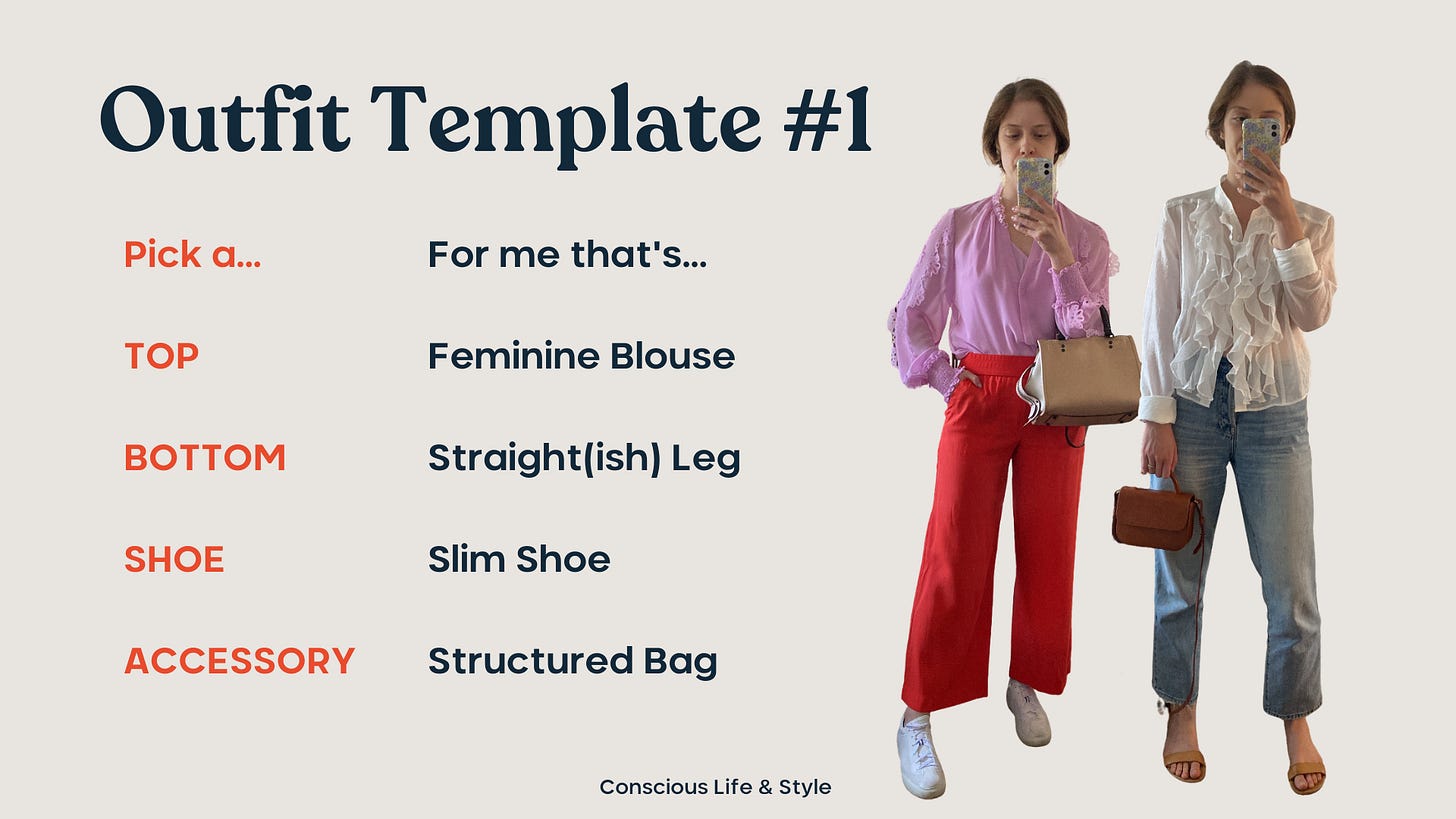
Here’s one of my work-from-home outfit templates that balances style and situational needs:
- Blouse with feminine detail: I start with the top for Zoom calls!
- Straight-leg bottoms: this could be jeans, colorful pants, or a column skirt
- Slim shoes: the general “slim” descriptor makes it versatile across seasons
- Structured bag: an option to add polish when coworking at a café
By thinking in these various layers (vibe, shapes, colors & textures, and lifestyle & values) you can build outfits that feel authentic to you while fitting the constraints of the external situation.
What About One-Off Unique Situations?
Like this Wednesday evening, I spoke on a “Sustainable Fashion in Action” panel with Chicago Climate Connect during Sustainable Fashion Week Chicago. But the panel was also taking place at the Patagonia x Worn Wear store.
So the vibe was professional meets fashion, but also kinda casual?! And we are still in the Midwest here. I have to say, this one wasn’t easy.
But here’s the step-by-step thought process that helped me balance my style, function, and a unique-to-me context.
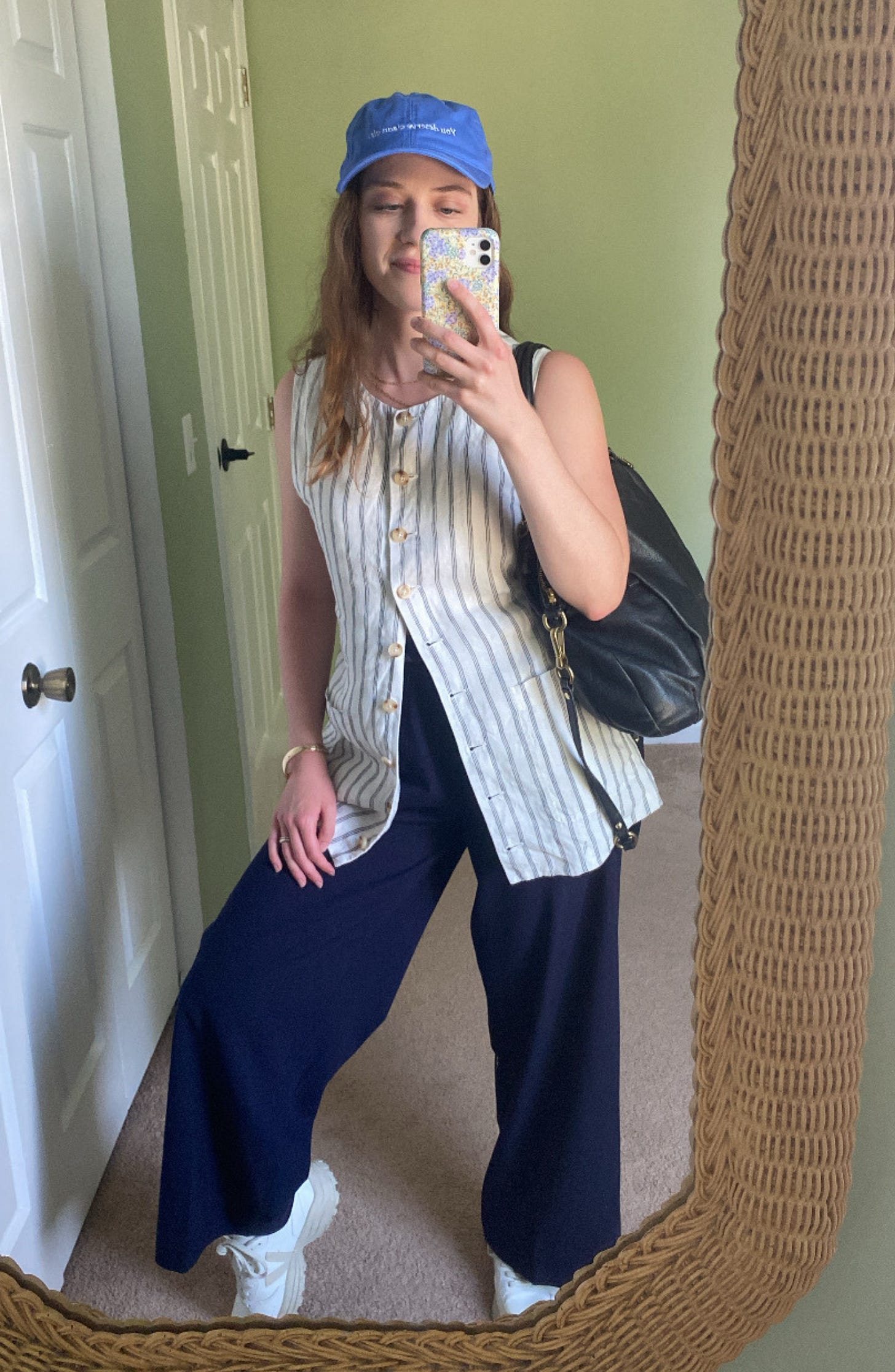
- I picked a foundational piece: My navy wide-leg trousers were business casual without being too formal and were practical for train travel.
- And functional accessories:My old Coach bag fits everything and my chunky Veja sneakers matched the vibe I was going for so those were the picks.
- Then a piece that brought it all together:At this point I was mixing high-contrast colors (white with navy & black) and different vibes (trousers vs. sneakers). I felt like I needed a bridge for the outfit, and this navy-striped vest tied it all together.
- Finally, some final touches: Gold jewelry made the look feel more “me”, while this cap from Abbie at The Filtery made it all feel effortless.
In the end, this outfit took a lot longer to create than a typical look.
It took longer to create than my usual outfits, but it felt just right. The combination was practical, suited my style, fit the vibe of the panel, and aligned with the weather.

This panel outfit reminded me that style is what we wear to express ourselves, but it’s also a tool to help us navigate our lives. By thinking through these layers of personal style (vibe, shapes, colors, textures, and lifestyle needs) we can balance showing up authentically while honoring the nuances or navigating the constraints of a situation.
For me, that’s the real power of personal style.
One single outfit can’t tell the whole story of who we are. But personal style can be flexible, functional, and expressive of the many sides of our multi-dimensional nature.
So lately, more than asking “does this outfit perfectly express my full self?” I’ve been finding myself asking:
“Does this outfit help me show up in the way I want to? Does it say what I want it to say in this particular moment?“
The post You’re multi-dimensional. So is your style. appeared first on .
-
Climate Change2 years ago
Spanish-language misinformation on renewable energy spreads online, report shows
-
Climate Change3 months ago
Guest post: Why China is still building new coal – and when it might stop
-
Climate Change Videos2 years ago
The toxic gas flares fuelling Nigeria’s climate change – BBC News
-

 Greenhouse Gases1 year ago
Greenhouse Gases1 year ago嘉宾来稿:满足中国增长的用电需求 光伏加储能“比新建煤电更实惠”
-
Greenhouse Gases3 months ago
Guest post: Why China is still building new coal – and when it might stop
-

 Climate Change1 year ago
Climate Change1 year ago嘉宾来稿:满足中国增长的用电需求 光伏加储能“比新建煤电更实惠”
-

 Carbon Footprint2 years ago
Carbon Footprint2 years agoUS SEC’s Climate Disclosure Rules Spur Renewed Interest in Carbon Credits
-
Renewable Energy3 months ago
US Grid Strain, Possible Allete Sale



